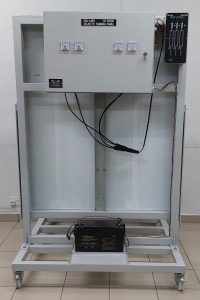Solar Photovoltaic Training System CE-60300Description
Request A Quotation
- Description
Description
TECHNICAL SPECIFICATION
- PV Control Panel Box
- 330 Watts Solar Panels With Adjustable Tilted System
- 30A MPPT PV Charge Controller
- Pure Sine Wave Inverter, 12V, 1200W
- 100Ah Lead Acid Battery
- AC MCB (AC Miniature Circuit Breaker)
- AC SPD (AC Surge Protection Device)
- DC MCB (DC Miniature Circuit Breaker)
- DC SPD (DC Surge Protection Device)
- AC Ammeter (0 ~ 5AAC)
- AC Voltmeter (0~250VAC)
- DC Ammeter (0 ~ 10ADC)
- DC Voltmeter (0 ~ 50VDC)
- Spot Light System
- Electrical Resistive Load
- Mobile Experiment Frame Complete With Battery Holder and Castor Wheel


ACCESSORIES
- Connector Cable Set
- MC4 Male and Female Cable Couplers
- MC4 2-To-1 Branch PV Cable Couplers
FEATURES
- Test the direct output of the PV panel
- Configure PV panel to achieve necessary voltage/current/power requirement
- Document I-W output at various light intensities and correlate light intensity to power generation
- Test various battery configuration (optional)
- Connect the PV array generation circuitry to storage batteries
- Document battery charge and discharge rates
- Connect the PV array circuitry to an AC inverter
- Drive an AC load with the PV array generation system
- Contains two solar photovoltaic modules mounted on an adjustable carriage which can be tilted for optimum exposure with a nominal voltage output of 17.3V DC at 5.8A
- An inverter that converts the DC to 240V AC single phase at 1200W
- A high-capacity 100Ah Lead Acid Battery
- Controls to monitor power from solar modules and to switch to battery power when necessary,
- Test terminals for power take-off points (12VDC and 240VAC), a 0~50V DC voltmeter, a 0~10ADC Ammeter, a 0~240V AC voltmeter and 0~5A AC Ammeter.
- The mobile frame is constructed of code gauge furniture stock steel with four swivel castors, two with locks.
- Control Box completed with all the internal and external wiring.
SYLLABUS COVER
The Solar Panel (Photovoltaic Panel)
- Photovoltaic cell, module, and panel
- Characteristic E-I curve of a PV cell
- Electric power output
- Irradiance
- Standard test conditions (STC)
- Efficiency
- Solar Panel Test Bench
- Monocrystalline Silicon Solar Panel
Effect of Temperature on Solar Panel Performance
- Effect of temperature on the output power
- Effect of temperature on the output voltage and current
- Characteristic E-I curve of a PV module operating at high temperature
- Open-circuit voltage and short-circuit current of a PV module operating at high temperature
- Maximum power point produced by a single PV module operating at high temperature
Storing Energy from Solar Panels into Batteries
- Energy storage
- Lead-acid batteries
- Battery charge using a PV module
- Battery connected to a PV module in the dark
- Equivalent diagram of a PV cell
- Blocking diode
Effect of Shading on Solar Panel Operation
- Effect of partial shading on PV panel operation
- Bypass diodes to mitigate the effect of shading on PV modules connected in series
- Blocking diodes to mitigate the effect of shading on PV modules connected in parallel
Solar Panel Orientation
- Introduction to the importance of solar panel orientation
- Earth’s orbit
- Sunlight at Earth’s surface
- Solar declination and Sun’s path in the sky
- Solar altitude angle at solar noon
- Optimal orientation of fixed PV panels
Note: Due to products continuous development process, layout and specification may change without prior notices.

